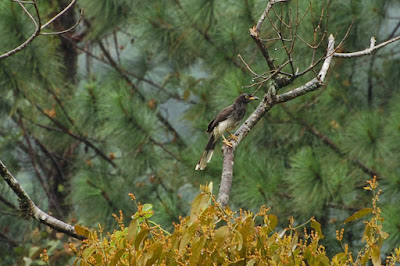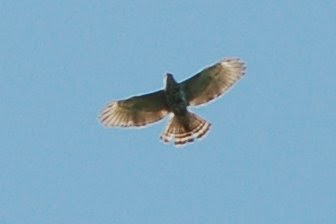Today was our second and last full day at Savegre (and lukily, void of rain)!
We woke before dawn to make a quick jaunt up the trails in hopes of Dusky Nightjar, a highland endemic. Without any leads (or ideas as to where to look/listen), we headed further up the mountain with our headlamps. Suddenly we stopped, a Dusky Nightjar was calling up the mountain! We were pretty stoked, what a way to start a day! (I had secretly put this pretty high on my "wish list" for this trip! Whew)
After coming down the trails, we birded our way down and around the headquarters before breakfast.
A Scintillant Hummingbird, a highland endemic, was seen on both our chilly mornings.
After breakfast, we met our guide for the morning, Melvin. After loading up in his vehicle, we were off to bird our way up the mountain! It wasn't long to realize that Melvin knew exactly what he was doing. What a help it was to have a local birder!
One of our first stops yielded many Volcano Hummingbirds, pictured above. This was another highland endemic.

At one of our stops, a hawk flew in (and stumped Melvin in the process). Later we decided it was probably a Broad-winged Hawk, just higher in elevation than they usually are.
New birds came quickly as we birded up the road. Some notables were highland endemics such as Black-billed Nightingale-Thrush and both Long-tailed and Black-and-yellow Silky-Flycatcher. However, perhaps most rewarding was when we crawled into the forest to try to coax in a Wrenthrush. It took a while, but we eventually were rewarded with actual views of this mega-skulker just a mere meter away!

One of the species I really wanted to see, the above pictured Sooty Robin, was easy to find up the mountain a bit. This highland endemic is related to our American Robin... but just so happens to be all black!
After reaching the Pan-American Highway 9 km up the way, we pulled off at a spot Melvin knew for Fiery-throated Hummingbird, photographed above. This was also a highland endmic.
Up above 3000 meters in elevation, the vegetation started to change into a short, stunted bamboo habitat, the Paramo! The views were amazing (even though it was cloudy), and at one point, it's sometimes possible to see both the Pacific Ocean to the west and the Carribean to the east from one spot! It's the only spot along the whole Pan-American Highway that this is possible.

Up in the Paramo, we took a couple panoramic shots. Makes sense, huh?
We started our hunt for many of the paramo endemics. Many of these species have extremely small ranges, limited to the tops of mountains between Costa Rica and Panama. Our first success came with a couple singing Timberline Wrens!

Another paramo specialty, the above pictured Volcano Junco, was another bird high on my wish list! We were treated to lengthy views of several (I might add that they're eerily tame)!

Although not limited only to the parmo habitats, the above Large-footed Finch is still a highland endemic. This skulker decided to pop up much to the delight of my Nikon.
Another huge highlight of mine was when we managed views of another Paramo specialty, the uncommon and endemic Peg-billed Finch!
By mid-day we headed back down to Savegre. We wandered the lodge grounds for a couple brief minutes. In the process, we found this exceedingly tame Yellowish Flycatcher, pictured below.
We had just sat down to lunch when I noticed my glass of water trembling. After asking Ashley why she was tapping the table with her foot, she said she wasn't! "Hmm" we thought, is this an earthquake or something? Turns out it WAS an earthquake, a first for both Ashley and I! Fortunately for us, it was centered NW of San Jose (and not at Savegre). However, and most unfortunately, it was a serious quake that killed over a dozen people and badly scarred many pristine birding spots.
After lunch, we made a last trek up the mountain to the Los Robles trail. I badly wanted to see the rare and local Silvery-throated Jay which was a possibility along certain parts of the trail. As luck would have it, at one point we heard the raspy calls of something, it just HAD to a be a jay! We bolted uptrail and stood gazing up as over a dozen Silvery-throated Jays started to filter through the tree tops! I was completely ecstatic. (Getting their picture was another story though!!)

One of my most-wanted species on this trip, I barely documented the highland endemic Silvery-throated Jay.
Overall, it was another great day of birding the highlands at Savegre! It was sad to know that our time in Costa Rica was drawing to a close.
Below is a list of NEW species for our trip seen today:
* = Highland endemic
* Finch, Peg-billed
* Flycatcher, Black-and-yellow Silky-
* Grosbeak, Black-thighed
Hawk, Broad-winged
* Hummingbird, Fiery-throated
* Hummingbird, Volcano
* Jay, Silvery-throated
* Junco, Volcano
* Nightjar, Dusky
Peppershrike, Rufous-browed
* Robin, Sooty
* Thrush, Black-billed Nightingale-
Woodpecker, Hairy
Wren, Gray-breasted Wood-
* Wren, Timberline
* Wrenthrush



















.JPG)



































.JPG)

